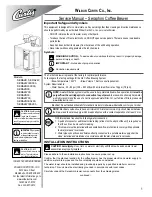
38
TIMW<13>, TMHW<15>, or CNTW<14>. No prefix is required when using a
TC number as a definer in a timer or counter instruction.
Once a TC number has been defined using one of these instructions, it can-
not be redefined elsewhere in the program either using the same or a differ-
ent instruction. If the same TC number is defined in more than one of these
instructions or in the same instruction twice, an error will be generated during
the program check. There are no restrictions on the order in which TC num-
bers can be used.
Once defined, a TC number can be designated as an operand in one or more
of certain set of instructions other than those listed above. When defined as a
timer, a TC number designated as an operand takes a TIM prefix. The TIM
prefix is used regardless of the timer instruction that was used to define the
timer. Once defined as a counter, the TC number designated as an operand
takes a CNT prefix. The CNT is also used regardless of the counter instruc-
tion that was used to define the counter.
TC numbers can be designated for operands that require bit data or for oper-
ands that require word data. When designated as an operand that requires
bit data, the TC number accesses the completion flag of the timer or counter.
When designated as an operand that requires word data, the TC number ac-
cesses a memory location that holds the PV of the timer or counter.
TC numbers are also used to access the SV of timers and counters from a
Programming Device. The procedures for doing so using the Programming
Console are provided in
7-6 Monitoring Operation and Modifying Data.
The TC area retains the SVs of both timers and counters during power inter-
ruptions. The PVs of timers are reset when PC operation is begun and when
reset in interlocked program sections. Refer to
5-7 Interlock and Interlock
Clear – IL(02) and ILC(03)
for details on timer and counter operation in inter-
locked program sections. The PVs of counters are not reset at these times.
Note that in programming “TIM 000” is used to designate three things: the
Timer instruction defined with TC number 000, the completion flag for this
timer, and the PV of this timer. The meaning in context should be clear, i.e.,
the first is always an instruction, the second is always a bit, and the third is
always a word. The same is true of all other TC numbers prefixed with TIM or
CNT.
3-9
LR (Link Relay) Area
The LR area is used as a common data area to transfer information between
PCs. This data transfer is achieved through a PC Link System, a SYSMAC
LINK System, or a SYSMAC NET Link System. Certain words will be allo-
cated as the write words of each PC. These words are written by the PC and
automatically transferred to the same LR words in the other PCs in the Sys-
tem. The write words of the other PCs are transferred in as read words so
that each PC can access the data written by the other PCs in the PC Link
System. Only the write words allocated to the particular PC will be available
for writing; all other words may be read only. Refer to the
PC Link System
Manual
,
SYSMAC LINK System Manual
, or
SYSMAC NET Link System Man-
ual
for details.
The LR area is accessible either by bit or by word. LR area word addresses
range from LR 00 to LR 63; LR area bit addresses, from LR 0000 to LR
6315. Any part of the LR area that is not used by the PC Link System can be
used as work words or work bits.
LR area data is not retained when the power is interrupted, when the PC is
changed to PROGRAM mode, or when it is reset in an interlocked program
TC Area
Section 3-8
















































